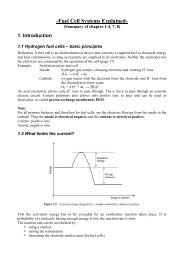Chapter 8. ORGANIC SOLAR CELLS - from and for SET students
Chapter 8. ORGANIC SOLAR CELLS - from and for SET students
Chapter 8. ORGANIC SOLAR CELLS - from and for SET students
Create successful ePaper yourself
Turn your PDF publications into a flip-book with our unique Google optimized e-Paper software.
<strong>SOLAR</strong> <strong>CELLS</strong> <strong>Chapter</strong> <strong>8.</strong> Exciton solar cells<br />
Figure <strong>8.</strong>4. Schematic drawing of the working principle of an organic photovoltaic cell.<br />
Illumination of a donor material (in red) through a transparent electrode (ITO) results in the<br />
<strong>for</strong>mation of an exciton (1). Subsequently, the exciton is transported by diffusion (2) to the<br />
interface between the donor material <strong>and</strong> an acceptor material (in blue). Electron is transferred<br />
to the acceptor material (A •- ), leaving a hole at the donor material (D •+ ) (3). The<br />
photogenerated charged carriers are then transported (4) to <strong>and</strong> collected at opposite<br />
electrodes (5). A similar charge generation process can occur, when the acceptor is<br />
photoexcited instead of the donor.<br />
<strong>8.</strong>4.1. Light absorption<br />
For an efficient collection of photons (process 1), the absorption spectrum of the photoactive<br />
organic layer should match the solar emission spectrum <strong>and</strong> the layer should be sufficiently<br />
thick to absorb most of the incident light. Generally the optical absorption coefficient (α) of<br />
organic materials is much higher than that of crystalline or multicrystalline silicon as shown<br />
in Figure <strong>8.</strong>5. For the conjugated polymers MDMO-PPV <strong>and</strong> P3HT <strong>and</strong> <strong>for</strong> the molecular<br />
dye, zinc phthalocyanine (ZnPc) α exceeds 1×10 5 cm -1 in the major part of the visible<br />
spectrum. Using Equation 3.38 this implies that a 100 nm thick organic layer is sufficient to<br />
reduce the light intensity to 1/e times its original value. For comparison, to obtain a similar<br />
decrease of the light intensity the crystalline silicon layer should be two orders magnitude<br />
thicker.<br />
The absorption coefficient spectra of MDMO-PPV <strong>and</strong> P3HT shown in Figure <strong>8.</strong>5<br />
lack absorption in the red <strong>and</strong> NIR part of the spectrum. As discussed previously <strong>for</strong> a<br />
photovoltaic cell based on a single light absorbing medium a b<strong>and</strong>-gap of approximately 1.1<br />
eV is optimal. By lowering the b<strong>and</strong> gap of the organic material it is possible to harvest more<br />
sunlight <strong>and</strong> there<strong>for</strong>e an increase in the photocurrent can be expected. For this reason much<br />
research ef<strong>for</strong>t is presently devoted to obtain organic polymers with an optical b<strong>and</strong> in the<br />
NIR, so called small b<strong>and</strong>-gap polymers. Though increasing the layer thickness is often<br />
advantageous <strong>for</strong> light absorption, charge transport might be hampered. This results in a lower<br />
the fill factor.<br />
-<strong>8.</strong>6-






